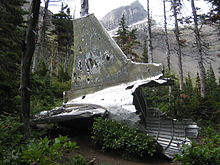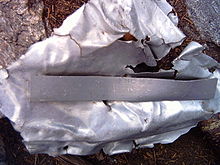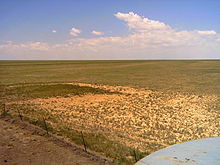
Maritime archaeology is a discipline within archaeology as a whole that specifically studies human interaction with the sea, lakes and rivers through the study of associated physical remains, be they vessels, shore-side facilities, port-related structures, cargoes, human remains and submerged landscapes. A specialty within maritime archaeology is nautical archaeology, which studies ship construction and use.

Trans World Airlines Flight 800 (TWA800) was a Boeing 747-100 that exploded and crashed into the Atlantic Ocean near East Moriches, New York, on July 17, 1996, at about 8:31 pm. EDT, 12 minutes after takeoff from John F. Kennedy International Airport, on a scheduled international passenger flight to Rome, with a stopover in Paris. All 230 people on board died in the crash; it is the third-deadliest aviation accident in U.S. history. Accident investigators from the National Transportation Safety Board (NTSB) traveled to the scene, arriving the following morning amid speculation that a terrorist attack was the cause of the crash. Consequently, the Federal Bureau of Investigation (FBI) and New York Police Department Joint Terrorism Task Force (JTTF) initiated a parallel criminal investigation. Sixteen months later, the JTTF announced that no evidence of a criminal act had been found and closed its active investigation.

Moffett Federal Airfield, also known as Moffett Field, is a joint civil-military airport located in an unincorporated part of Santa Clara County, California, United States, between northern Mountain View and northern Sunnyvale. On November 10, 2014, NASA announced that it would be leasing 1,000 acres (400 ha) of the airfield property to Google for 60 years.

A shipwreck is the wreckage of a ship that is located either beached on land or sunken to the bottom of a body of water. Shipwrecking may be intentional or unintentional. Angela Croome reported in January 1999 that there were approximately three million shipwrecks worldwide.

Wreck diving is recreational diving where the wreckage of ships, aircraft and other artificial structures are explored. Although most wreck dive sites are at shipwrecks, there is an increasing trend to scuttle retired ships to create artificial reef sites. Diving to crashed aircraft can also be considered wreck diving. The recreation of wreck diving makes no distinction as to how the vessel ended up on the bottom.
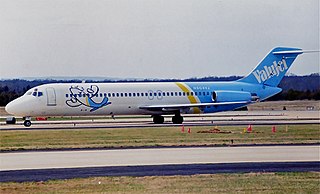
ValuJet Airlines Flight 592 was a regularly scheduled flight from Miami International Airport to Hartsfield–Jackson Atlanta International Airport. On May 11, 1996, the ValuJet Airlines McDonnell Douglas DC-9 operating the route crashed into the Everglades about 10 minutes after taking off from Miami as a result of a fire in the cargo compartment caused by mislabeled and improperly stored hazardous cargo. All 110 people on board died. The airline already had a poor safety record before the crash, and the accident brought widespread attention to the airline's problems. The airline was grounded for several months after the accident. When operations resumed, ValuJet was unable to attract the same numbers of customers as it had before the accident. It acquired AirTran in 1997, but the lingering damage to the ValuJet name led ValuJet executives to assume the AirTran name.
Dillingham Airfield is a public and military use airport located two nautical miles (4 km) west of the central business district of Mokulēʻia, in Honolulu County on the North Shore of Oʻahu in the U.S. state of Hawaii. It is operated by the Hawaii Department of Transportation under a 25-year lease from the United States Army. The airport is primarily used for gliding and sky diving operations, and also houses Civil Air Patrol (CAP) glider aircraft. Military operations consist largely of night operations for night vision device training and orientation flights for the United States Air Force Auxiliary (CAP). This airport is included in the Federal Aviation Administration (FAA) National Plan of Integrated Airport Systems for 2017–2021, in which it is categorized as a basic general aviation facility.

A flight recorder is an electronic recording device placed in an aircraft for the purpose of facilitating the investigation of aviation accidents and incidents. The device may often be referred to as a "black box", an outdated name which has become a misnomer—they are now required to be painted bright orange, to aid in their recovery after accidents.

Kam Air Flight 904 was a scheduled passenger domestic flight, flying from Herat Airfield in Herat to Kabul International Airport in Afghanistan's capital of Kabul. On 3 February 2005, the aircraft impacted mountainous terrain, killing all 97 passengers and 8 crew on board.

Fort Worth Meacham International Airport is a general aviation airport located near the intersection of Interstate 820 and Business U.S. Highway 287 in Fort Worth, Texas, United States. It is named after former Fort Worth Mayor Henry C. Meacham. The airport covers 745 acres.

Miami-Opa Locka Executive Airport is a joint civil-military airport located in Miami-Dade County, Florida 11 mi (18 km) north of downtown Miami. Part of the airport is in the city limits of Opa-locka. The National Plan of Integrated Airport Systems for 2011–2015 called it a general aviation reliever airport.

The town of Broome, Western Australia, was attacked by Japanese fighter planes on 3 March 1942, during World War II. At least 88 civilians and Allied military personnel were killed.

Addison Airport is a public airport in Addison, in Dallas County, Texas, United States, 9 mi north of downtown Dallas. It opened in 1954 and was purchased by the town of Addison in 1976. It is home to the Cavanaugh Flight Museum.

Mungalalu Truscott Airbase or Truscott-Mungalalu Airport, which during World War II was known as Truscott Airfield is today a commercial airport in the remote Kimberley region of Western Australia.

The Protection of Military Remains Act 1986 is an Act of Parliament in the United Kingdom that provides protection for the wreckage of military aircraft and designated military vessels. The Act provides for two types of protection: protected places and controlled sites. Military aircraft are automatically protected, but vessels have to be specifically designated. The primary reason for designation is to protect as a 'war grave' the last resting place of British servicemen ; however, the Act does not require the loss of the vessel to have occurred during war.
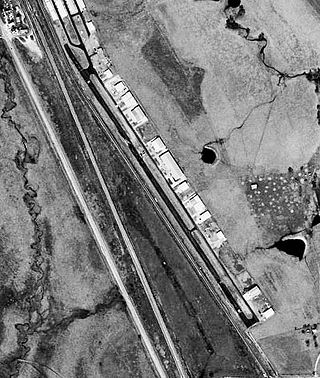
Hicks Airfield is a public use airport located 14 nautical miles northwest of the central business district of Fort Worth, in Tarrant County, Texas, United States. The airport is used solely for general aviation purposes.

The Colorado Aviation Historical Society (CAHS) is located at the Wings Over the Rockies Air and Space Museum Old Lowry AFB Campus, Denver, CO and was founded in 1966. The Society acquires, restores, preserves and provides for public display, aircraft and other objects, documents, items and things of present or historical interest or value in connection with the development and history of aviation in the State of Colorado. CAHS hosts many aviation events and participates in many of Colorado's air shows and fly-ins. The Society has regular membership meetings and publishes a quarterly history journal. The Society owns an Alexander Eaglerock Model 24 Long Wings airplane which is on display at the Wings Over the Rockies Air and Space Museum. The Society also owns a Steen Skybolt aerobatic biplane which is on display at the Pueblo Weisbrod Aircraft Museum Pueblo Airport, Pueblo, CO.

HMS M2 was a Royal Navy submarine monitor completed in 1919, converted in 1927 into a submarine aircraft carrier. She was wrecked in Lyme Bay, Dorset, Britain, on 26 January 1932. She was one of three M-class boats completed.

National Airlines Flight 102 was a cargo flight operated by National Airlines between Camp Bastion in Afghanistan and Al Maktoum Airport in Dubai, with a refueling stop at Bagram Airfield, Afghanistan. On 29 April 2013, the Boeing 747-400 operating the flight crashed moments after taking off from Bagram, killing all seven people on board.

Atlas Air Flight 3591 was a scheduled domestic cargo flight under the Amazon Air banner between Miami International Airport and George Bush Intercontinental Airport in Houston. On February 23, 2019, the Boeing 767-375ER(BCF) used for this flight crashed into Trinity Bay during approach into Houston, killing the two crew members and single passenger on board. The accident occurred near Anahuac, Texas, east of Houston, shortly before 12:45 CST (18:45 UTC). This was the first fatal crash of a Boeing 767 freighter.
